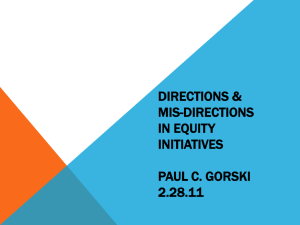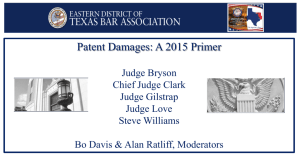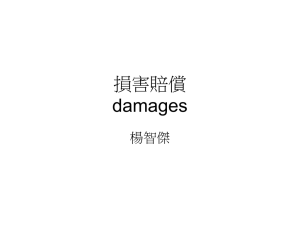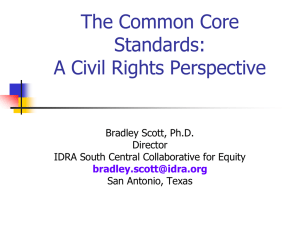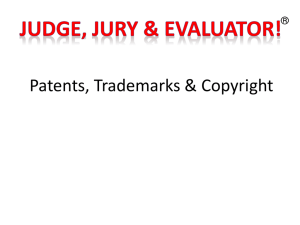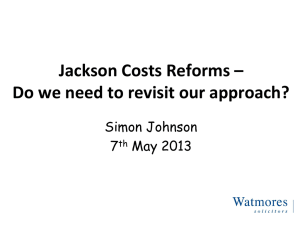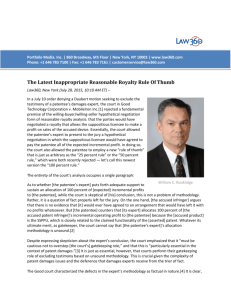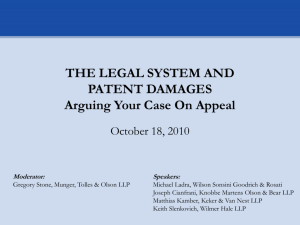Reasonable Royalties Are An Equitable Remedy
advertisement
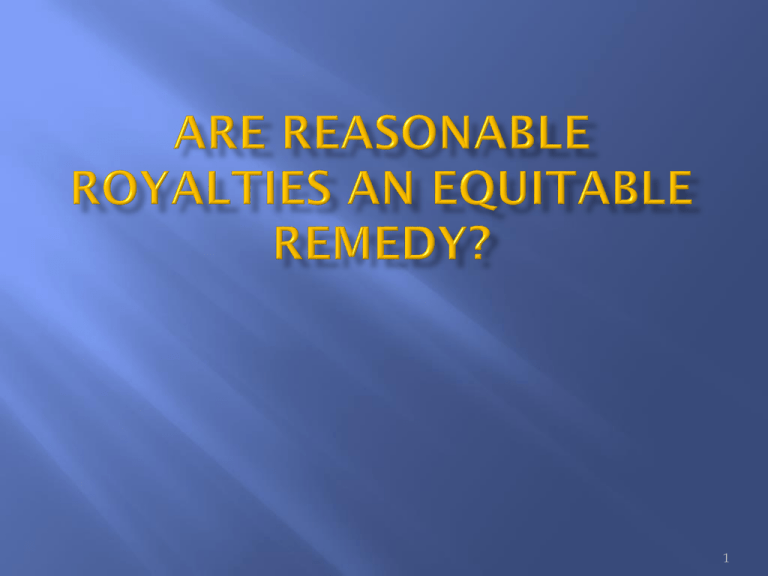
1 In a patent case, if the issue were one that would have been tried to a jury at common law at the time of the founding of our country, or analogous to such an issue, the Seventh Amendment requires a jury trial on that issue. Markman v. Westview Instr., 517 U.S. 370 (1996). 2 Trial court’s future ongoing royalties were an equitable remedy in lieu of an injunction. No Seventh Amendment right to trial for damages that are given as an equitable remedy. Paice LLC v. Toyota Motor Corp., 504 F.3d 1293 (Fed. Cir. 2007), cert. denied, 128 S.Ct. 2430 (2008). 3 Actions that seek only injunctive relief, attorneys’ fees, costs, or other solely equitable relief do not give rise to Seventh Amendment protection. Tegal Corp. v. Tokyo Electron Am., Inc., 257 F.3d 1331 (Fed. Cir. 2001). 4 1790 patent act (the first patent act), all claims for patent infringement were actions at law and the statute explicitly required the jury to set the damages. Federal Courts had no equity jurisdiction prior to 1819. All patent cases in federal courts prior to that date were brought as actions at law. To bring an action in equity, for an injunction and accounting, the case had to be filed in a state court. 5 1870 Patent Act, patentee could elect to proceed in equity and recover infringer's profits and an injunction, or to proceed in law and recover "as damages, compensation for pecuniary injury he suffered by the infringement." Birdsall v. Coolidge, 93 U.S. (3 Otto) 64, 68-69, 23 L.Ed. 802 (1876). However, patentee was required to choose between these paths of recovery. See, Nike v. Wal-Mart Stores, 138 F.3d 1437 (Fed. Cir. 1997) for a history of patent act amendments and their impact on law and equity. 6 Prior to merger of law and equity, recovery in law was limited to patentee’s actual loss, such as lost profits or a mathematical formula for damages or loss of an established royalty where patentee had licensees. In an action at law, if no actual loss could be proven according to legal standards, then jury had to be instructed to find nominal damages. Coupe v. Royer, 155 U.S.565, 583 (1895). 7 In a 1915 case in equity, the U.S. Supreme Court endorsed the remedy of a “reasonable royalty” where no damages could be shown. The Court expressly noted that Coupe v. Royer was an action at law in distinguishing that case from the equity case at hand. The Court explicitly relied on principles in equity in adopting this remedy. Dowagiac Mfg. Co. v. Minnesota Moline Plow, Co., 235 U.S. 641 (1915). 8 In Dowagiac Mfg. Co., the Court relied on equitable principles to endorse reasonable royalty damages: “As was said in Tilghman v. Proctor, 125 U.S. 136, 145, 31 L. Ed. 664, 667, 8 S. Ct. 894: 'It is inconsistent with the ordinary principles and practice of courts of chancery, either, on the one hand, to permit the wrongdoer to profit by his own wrong, or, on the other hand, to make no allowance for the cost and expense of conducting his business, or to undertake to punish him by obliging him to pay more than a fair compensation to the person wronged.'” 9 In Dowagiac Mfg. Co., the Court further explained its application of equitable principles to justify reasonable royalty damages: “But, as the patent had been kept a close monopoly, there was no established royalty. In that situation it was permissible to show the value by proving what would have been a reasonable royalty, considering the nature of the invention, its utility and advantages, and the extent of the use involved.” 10 "The actual damages which will sustain a judgment must be established, not by conjectures or unwarranted estimates of witnesses, but by facts from which their existence is logically and legally inferable. The speculations, guesses, estimates of witnesses, from no better basis of recovery than the speculations of the jury themselves. Facts must be proved, data must be given which form a rational basis for a reasonably correct estimate of the nature of the legal injury and of the amount of the damages which resulted from it, before a judgment of recovery can be lawfully rendered." Central Coal & Coke Co. v. Hartman, 111 F. 96, 98 (8th Cir. 1901). 11 After the 1938 merger of law and equity in the Federal Courts, If any damages at law could be proven, even if minimal, then equitable remedy of a reasonable sum was not available: No equitable damages could be awarded in the unified system when there was a legal damages remedy. This was so even if damages at law were less than what could have been sought in equity. UCLA Journal of Law & Technology, Vol. 13, Issue 2, Erick S. Lee, at page 7. 12 January 10, 1950, House Judiciary Committee Report to what is now 28 U.S.C. Section 284 13 Former Equity Damages Statute R.S. 4921 (Excerpted in relevant part): 14 Former Damages Statute for Action at Law 15 May 12, 1953 House Report, p. 29 H. 82-2.7 16 Georgia-Pacific is the leading case on reasonable royalties and the hypothetical negotiation model for them in patent cases. The Second Circuit opinion in Georgia-Pacific cited the 1952 legislative history and also described “reasonable royalty” in classic equity terms: “The whole notion of a reasonable royalty is a device in aid of justice, by which that which is really incalculable shall be approximated, rather than that the patentee, who has suffered an indubitable wrong, shall be dismissed with empty hands.” Georgia-Pacific Corp. v. US Plywood-Champion Papers Inc., 446 F. 2d 295, at fn. 5 (2d Cir. 1971) 17 In Innogenetics v. Abbott Labs, 512 F.3d 1363, 1380 (Fed Cir. 2008), the court vacated an injunction because the royalty awarded was mainly a market entry fee, which included at least partial payment for future use. Innogenetics demonstrates that the flexibility of the hypothetical negotiation model for a reasonable royalty (including speculation on money towards future infringement), is an equitable remedy. 18 The1952 Patent Acts’ “reasonable royalty” derives from equity: It is a combination of the Revisions from 1870 Patent Act’s equitable remedies’ statute R.S. 4912. Hypothetical negotiation not available in action at law. In 1970, Georgia-Pacific: Second Circuit discusses reasonable royalty in classic equitable terms. In 2007, Paice shows future royalties are equitable and no right to a jury trial under Seventh Amendment. In 2007, Innogenetics shows that a single lump sum hypothetical negotiation-reasonable royalty damage award can include payment for future use that will not permit for an injunction going forward. Reasonable Royalty is a form of equitable damages. 19

